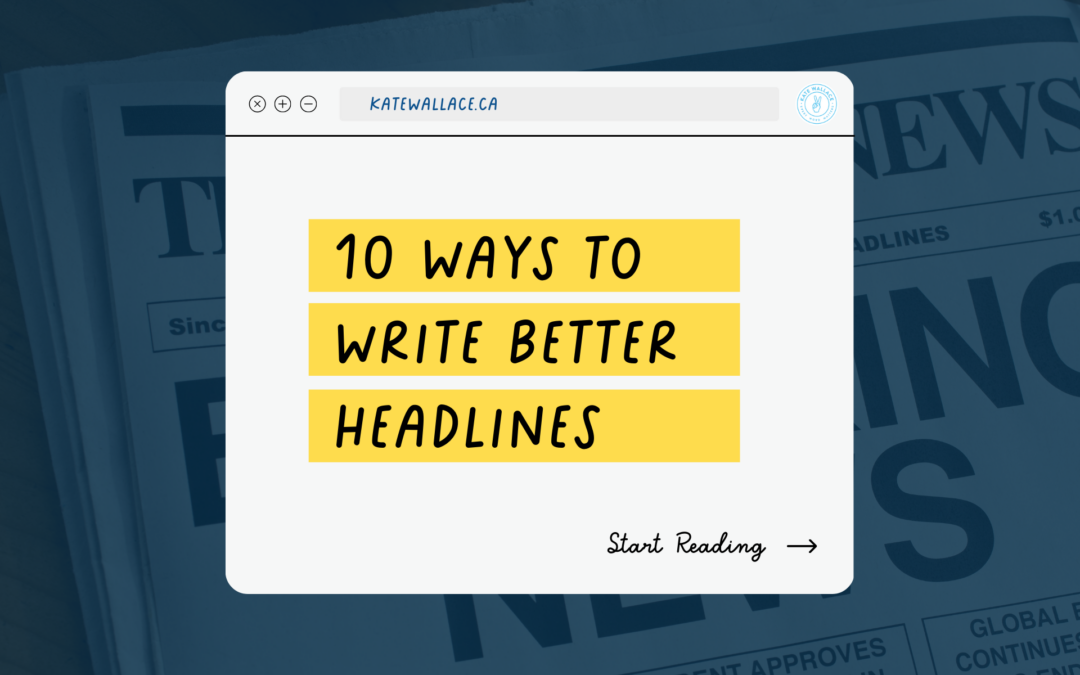Updated April 2023
Did You Know: Headlines with 10–13 words attract TWICE as much site traffic, but a great headline is so much more than just a matter of hitting a specific word count.
A great headline rises above the rabble, getting you noticed in a very noisy world.
So why do we—hey, I’m guilty of it, too—treat them as an afterthought?
Perhaps it’s because, by the time we’ve spent an hour or two (or more) writing a post, we’re ready to be done with it.
And also: it’s hard!
Writing a great headline is an exercise in concision, creativity and brevity, three of the toughest elements of strong writing.
Don’t despair, though. Here are ten ways to craft a hooky headline (or caption or subject line) that will get looks and clicks, and read-throughs without being salesy or slimy. (Don’t worry, you only need to pick one!).
1. Inform
In a smackdown between being clear and being clever or cute, clarity wins.
If you’re struggling to write something witty or wise—if you’ve gotten yourself so twisted up in double entendres that you’ve lost the plot of what you’re trying to say—stop fighting. Go back to basics.
Write a classic news headline with just the facts, ma’am. In one sentence, describe what your piece is about. If someone remembered nothing else, what is essential? Now write that headline in 13 words or less. Use facts and stats—no bloated cliches, just lean, direct prose that’s as short and as specific as possible.
A recent series from the New York Times is titled “What We Spent in a Month.”
No adjectives, no flash, and compelling as hell.
2. Improvement
Improvement headlines state the promise, often by emphasizing the gap between one’s current and desired end-states, like this: “Sick of slaving over your starter? Sourdough for lazy bakers.” (I made that up, but I need that article in my life. Please forward if you find it).
Many blog posts (including this one) and pieces of content are about sharing experiences and imparting wisdom to help your audience get better at something, be it copywriting or vermicomposting (my husband’s latest interest, don’t ask).
3. Intrigue
Showcase the unexpected, give a teaser, and ignite curiosity. Just make sure your post delivers on the promised intrigue of the headline.
If there’s something quirky or strange in your post, then, by George, use it!
In journalism school, I learned about the famous headline “Headless body found in a topless bar,” and it still thrills me.
4. Identification
Create a connection with your audience by speaking their language, whether through subject or word choice.
Use slang, idioms, and references to create a sense of connection, like this Millenial-flavoured one from the now-defunct Repeller: “3 Instagram-Inspired Interior Design Trends to Buy, Like, Immediately.”
Not your grandma’s headline.
5. Instigation
Sometimes, you want to challenge the status quo, shake things up, and arouse a reaction. A bold, contrarian or even controversial headline is perfect for these situations.
Use sparingly for maximum impact.
6. Itemization
Lists, roundup, top 10s: this headline lets your reader know you’ve got some quick-hit information (or even just a fun pop-culture listicle) for them, like this post.
Buzzfeed is so good at this. I swear, I’ve read some version of “33 Genius Products That’ll Actually Help You Get Some Work Done At Home” at least 33 times, and I’ll keep clicking.
7. Inspiration
Bring on the big feelings! Inspiring headlines are all about driving emotion and nurturing empathy.
Inspiring headlines can take many forms, but quotations (either from your piece or an inspiring person) are common and can inspire empathy.
It doesn’t need to be heavy or serious, though. The classic “What We’re Loving Now” headline works for lighter inspo-driven pieces.
8. Instilling (curiosity)
Many of the writers I follow do this thing where they use short, snappy, yet vague subject lines in their emails, and I’m a fan.
Seth Godin is a pro at this:
- “Code Words.”
- “The Right Amount of Time.”
- “Insignificant digits.”
They hook me every time, giving me just enough of a teaser to lead me to want more. Of course, I know from experience to expect thoughtful content too.
Or from Ann Handley, the godmother of copywriting: “Pumpkin Spice Couches: A Case Study in the Power of Copywriting.” What the heck is a pumpkin spice couch, and how does it relate to copywriting?
I had to know, so I clicked.
9. Integration (of multiple approaches)
“Screw bitcoin. Cash in on email instead. (21 ways to do it better!).”
This headline from email copywriter Laura Belgray is masterful, combining three headline styles:
- Instigate (Screw bitcoin).
- Inform (Cash in on email instead).
- Itemize (21 ways to do it better).
Laura’s a seasoned pro, so start with one and work your way up to double or triple-header headline approaches.
10. Imitation
Keep a running file of headlines that get your attention. Bookmark them, and save them in your email. Figure out what made them so compelling.
Then adapt it to your use.
Go for quantity
With the recent burst of ChatGPT onto the scene it’s opened up a whole new world of opportunity for writers. My favourite way to use it so far has been to get the ball rolling on things I’m feeling stuck on, and headlines is one of the things I’m always getting stuck on.
Try using a Chat Bot to spit out a handful of headline ideas based on what you’ve written and edit them as much or as little as you need to make them hit.



